Java设计模式之开闭原则精解
作者:张起灵-小哥
设计模式(Design pattern)代表了最佳的实践,通常被有经验的面向对象的软件开发人员所采用。设计模式是软件开发人员在软件开发过程中面临的一般问题的解决方案。本篇介绍设计模式七大原则之一的开闭原则
1.什么是开闭原则?
- 开闭原则(Open Closed Principle)是编程中最基础、最重要的设计原则。
- 一个软件实体如类,模块和函数应该对扩展开放(对提供方),对修改关闭(对使用方)。用抽象构建框架,用实现扩展细节。
- 当软件需要变化时,尽量通过扩展软件实体的行为来实现变化,而不是通过修改已有的代码来实现变化。
- 编程中遵循其它原则,以及使用设计模式的目的就是遵循开闭原则。
2.违反Ocp代码案例
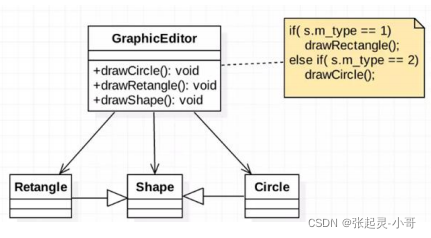
package com.szh.principle.ocp;
/**
*
*/
//Shape类,基类
class Shape {
int m_type;
}
class Rectangle extends Shape {
Rectangle() {
super.m_type = 1;
}
}
class Circle extends Shape {
Circle() {
super.m_type = 2;
}
}
//这是一个用于绘图的类 [使用方]
class GraphicEditor {
//接收Shape对象,然后根据type,来绘制不同的图形
public void drawShape(Shape s) {
if (s.m_type == 1)
drawRectangle(s);
else if (s.m_type == 2)
drawCircle(s);
}
//绘制矩形
public void drawRectangle(Shape r) {
System.out.println(" 绘制矩形 ");
}
//绘制圆形
public void drawCircle(Shape r) {
System.out.println(" 绘制圆形 ");
}
}
public class Ocp {
public static void main(String[] args) {
//使用看看存在的问题
GraphicEditor graphicEditor = new GraphicEditor();
graphicEditor.drawShape(new Rectangle());
graphicEditor.drawShape(new Circle());
}
}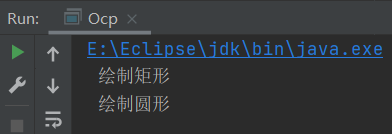
根据上面的代码及运行结果来看,没一点问题,我们如愿的画出了矩形、圆形。但是现在有了一个新的需求,说 要增添一个图形(三角形),使代码完成对三角形的绘制,那么我们就需要对上面的代码进行修改。
package com.szh.principle.ocp;
/**
*
*/
//Shape类,基类
class Shape {
int m_type;
}
class Rectangle extends Shape {
Rectangle() {
super.m_type = 1;
}
}
class Circle extends Shape {
Circle() {
super.m_type = 2;
}
}
//新增画三角形
class Triangle extends Shape {
Triangle() {
super.m_type = 3;
}
}
//这是一个用于绘图的类 [使用方]
class GraphicEditor {
//接收Shape对象,然后根据type,来绘制不同的图形
public void drawShape(Shape s) {
if (s.m_type == 1)
drawRectangle(s);
else if (s.m_type == 2)
drawCircle(s);
else if (s.m_type == 3)
drawTriangle(s);
}
//绘制矩形
public void drawRectangle(Shape r) {
System.out.println(" 绘制矩形 ");
}
//绘制圆形
public void drawCircle(Shape r) {
System.out.println(" 绘制圆形 ");
}
//绘制三角形
public void drawTriangle(Shape r) {
System.out.println(" 绘制三角形 ");
}
}
public class Ocp {
public static void main(String[] args) {
//使用看看存在的问题
GraphicEditor graphicEditor = new GraphicEditor();
graphicEditor.drawShape(new Rectangle());
graphicEditor.drawShape(new Circle());
graphicEditor.drawShape(new Triangle());
}
}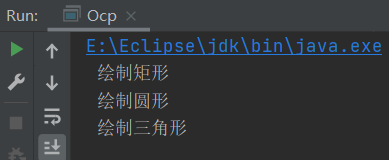
对代码的修改完成了,也按照要求绘制出了三角形。但是大家仔细对比上面这两段代码,你会发现:第一,改动的地方偏多;第二,在使用方 GraphicEditor 类中也做了修改。 这就明显违反了开闭原则中的 对修改关闭 这个规则。
我们需要的是 对扩展开放,对修改关闭 的规则,也就是说增添一个三角形的时候,我们只需要在提供方做修改,在使用方是无需修改的。
也就是说,当我们给一个类增添新的功能时,尽量不修改代码,或者是尽量少的修改代码。
3.遵守Ocp代码案例
思路: 把创建Shape类做成抽象类,并提供一个抽象的draw方法,让子类去实现即可,这样我们有新的图形种类时,只需要让新的图形类继承Shape,并实现 draw方法即可,使用方的代码就不需要修 → 满足了开闭原则。
package com.szh.principle.ocp.improve;
/**
*
*/
//Shape类,基类
abstract class Shape {
int m_type;
public abstract void draw();//抽象方法
}
class Rectangle extends Shape {
Rectangle() {
super.m_type = 1;
}
@Override
public void draw() {
System.out.println(" 绘制矩形 ");
}
}
class Circle extends Shape {
Circle() {
super.m_type = 2;
}
@Override
public void draw() {
System.out.println(" 绘制圆形 ");
}
}
//这是一个用于绘图的类 [使用方]
class GraphicEditor {
//接收Shape对象,调用draw方法
public void drawShape(Shape s) {
s.draw();
}
}
public class Ocp {
public static void main(String[] args) {
GraphicEditor graphicEditor = new GraphicEditor();
graphicEditor.drawShape(new Rectangle());
graphicEditor.drawShape(new Circle());
}
}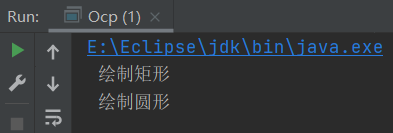
上面是改进之后的代码,此时我们还像之前的案例一样,增添一个新的图形(三角形),并完成对三角形的绘制,那么对上面代码的修改就少之又少了。
修改代码如下:👇👇👇
package com.szh.principle.ocp.improve;
/**
*
*/
//Shape类,基类
abstract class Shape {
int m_type;
public abstract void draw();//抽象方法
}
class Rectangle extends Shape {
Rectangle() {
super.m_type = 1;
}
@Override
public void draw() {
System.out.println(" 绘制矩形 ");
}
}
class Circle extends Shape {
Circle() {
super.m_type = 2;
}
@Override
public void draw() {
System.out.println(" 绘制圆形 ");
}
}
//新增画三角形
class Triangle extends Shape {
Triangle() {
super.m_type = 3;
}
@Override
public void draw() {
System.out.println(" 绘制三角形 ");
}
}
//这是一个用于绘图的类 [使用方]
class GraphicEditor {
//接收Shape对象,调用draw方法
public void drawShape(Shape s) {
s.draw();
}
}
public class Ocp {
public static void main(String[] args) {
GraphicEditor graphicEditor = new GraphicEditor();
graphicEditor.drawShape(new Rectangle());
graphicEditor.drawShape(new Circle());
graphicEditor.drawShape(new Triangle());
}
}可以看到,我们对提供方代码中新增了一个 Triangle 类,它来完成对三角形的绘制。而自始至终我们的使用方 GraphicEditor 类都没有做任何的修改。
这就自然而然的满足了开闭原则中的 对扩展开发、对修改关闭 了。
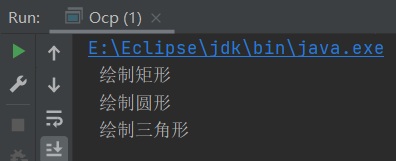
到此这篇关于Java设计模式之开闭原则精解的文章就介绍到这了,更多相关Java 开闭原则内容请搜索脚本之家以前的文章或继续浏览下面的相关文章希望大家以后多多支持脚本之家!
